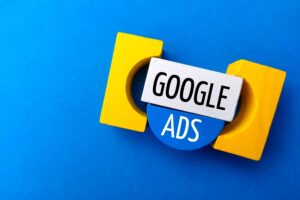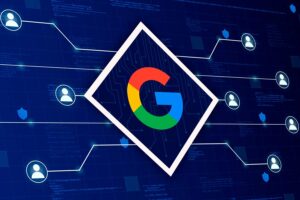Google Ads has unique trends and features that are crutial to undertand as it continues to be a pivotal tool for PPC experts aiming to enhance their online marketing strategies and connect effectively with target audiences.
The dynamic nature of the digital landscape necessitates a proactive approach in keeping up with and leveraging the latest Google Ads trends and features. This evolution is fueled by advancements in AI and machine learning. Those elements enable marketers to launch highly targeted campaigns that adapt seamlessly to the changing online environment.
Embracing the newest developments in Google Ads will be crucial for staying ahead in a competitive market. This article delves into key trends such as AI and automation in Google Ads. We will review elements such as: the increasing importance of video advertising, the strategies for perfecting audience targeting or the shift towards mobile and voice search.
Embracing AI and Automation in Google Ads
AI and Automation are dominating digital advertising strategies, therefore let´s start our guide here.
It´s a fact that Google Ads is enhancing its platform with a suite of AI-driven features designed to streamline ad creation, optimize audience targeting, and provide predictive insights that refine campaign strategies.
Let’s see some details that will help you to understand how AI and Automation are shaping the ads world.
Management with AI-Powered Features and Automation Tools
Managment is one of the areas where AI and automation are making a revolution. With the introduction of features like semi-autonomous ad creation and enhanced audience targeting, advertisers can now launch more effective campaigns with less manual intervention. Predictive analytics offer a glimpse into future consumer behaviors, enabling advertisers to adjust strategies proactively.
Smart Bidding and Strategic Insights
The adoption of smart bidding strategies such as Target CPA (Cost Per Acquisition) and ROAS (Return on Ad Spend) is on the rise. These AI-powered tools automatically adjust bids in real-time, maximizing the effectiveness of ad spend based on the specific goals of each campaign. This not only boosts efficiency but also enhances the strategic depth of campaign management.
Continuous Learning and Improvement
Google Ads’ commitment to continuous learning and improvement through AI is evident in its ongoing updates and feature enhancements. This approach ensures that the platform remains at the forefront of digital advertising technology, providing users with the tools they need to stay competitive in a rapidly evolving market.
By leveraging AI to its full potential, Google Ads is setting a new standard for efficiency and effectiveness in digital advertising. The integration of AI not only simplifies the management of complex campaigns but also empowers advertisers with deep insights that drive more engaging and successful ad experiences.
Once we´ve reviewed the increasing use of AI and Automation in digital advertising, let´s move on to unveil another trend.
The Rise of Video Advertising
Video advertising is rapidly evolving, becoming a dominant force in digital marketing strategies due to its engaging and versatile nature. Platforms like YouTube Shorts, Meta Reels, and TikTok are spearheading this trend with their short-form video content, capturing the attention of a global audience. These platforms offer a unique blend of entertainment and information, making video ads an effective tool for marketers aiming to engage and convert viewers.
Technological advancements such as faster internet speeds and data-driven targeting are enhancing the effectiveness of video advertising. These technologies enable advertisers to deliver content that is not only high in quality but also tailored to the interests and behaviors of individual viewers. Interactive and immersive ad formats are further enriching the viewer experience, making ads feel less like interruptions and more like part of the entertainment.
The rise of visual search technology is also transforming how consumers interact with video content. This technology allows users to search for products and information directly through visual cues within the video, creating a seamless integration of advertising and content consumption. As a result, video advertising is not just about delivering a message but also about creating an interactive experience that enhances consumer engagement.
Marketers are recognizing the power of video and are increasingly allocating resources to this format. The dynamic nature of video content, combined with its ability to convey stories and emotions effectively, makes it an invaluable tool for digital advertising. This trend is expected to continue, with innovations in technology and format playing a key role in its growth.
Move on now to another trend that right now has a huge importance in digital advertising.
Perfecting Audience Targeting with Advanced Segmentation
In today’s digital age, targeting your audience is more crucial than ever and Google Ads advanced segmentation techniques allow businesses to target their audience in a more precise and personalized way.
Through deep analysis of user behaviors and preferences, along with the use of sophisticated algorithms and detailed demographic data, Google Ads provides a nuanced understanding of potential customers. These advanced techniques not only expand the potential customer base but also significantly improve the effectiveness of campaigns, especially through personalized messages that are more likely to convert, leading the way to more effective and efficient advertising.
Advanced Segmentation Techniques in Google Ads
Google Ads’ advanced segmentation is changing the advertising game, offering advertisers a smarter way to reach their audience. By digging into user behavior and preferences, it’s enabling a deeper connection with potential customers. With Broad Match, advertisers can now catch the true intent behind searches, making sure their ads meet the right eyes for better engagement. Voice search integration is another game-changer, allowing for ads that talk directly to the user’s needs, boosting ad relevance dramatically.
The magic doesn’t stop there. Google’s algorithms are playing matchmaker by pairing new users with similar characteristics to existing customers, expanding the customer base with precision targeting. And with detailed demographic data, advertisers can tailor their messages like never before, hitting the sweet spot for various audience segments.
Custom segments and dynamic audience management are the cherries on top, enabling advertisers to fine-tune their targeting strategies in real-time, ensuring ads are not just seen but resonate deeply. In essence, Google Ads’ advanced techniques mean ads can be more personalized, effective, and efficient, ensuring every ad dollar works harder and smarter.
Navigating the Shift Towards Mobile and Voice Search
As the digital landscape evolves, the shift towards mobile and voice search is becoming increasingly significant for PPC experts and marketers. With mobile device advertising projected to grow rapidly, reaching an estimated $399.6 billion by 2024, the importance of optimizing for mobile cannot be overstated. This growth is driven by the enhanced capabilities of mobile devices and the convenience they offer to users seeking information on the go.
Mobile Optimization and User Experience
To capitalize on this trend, it is crucial to prioritize responsive design and mobile-specific ad formats. These elements ensure that ads are not only visually appealing but also functional across different device types. Implementing features like dynamic image ads and 360-degree product previews can significantly enhance the user experience by providing interactive and engaging content that captures attention.
Voice Search: The New Frontier
Voice search is transforming how users interact with online content, with queries becoming more conversational and extending beyond simple keywords. This change requires a shift in how PPC campaigns are structured. Keywords need to be more natural and reflective of spoken language, and content must be optimized to appear in featured snippets, which are commonly read aloud in voice search responses.
Integrating Advanced Technologies
Augmented Reality (AR) and video integration in search ads are set to play a pivotal role in the future of mobile advertising. These technologies provide a richer, more immersive experience for users, making ads more interactive and engaging. For instance, AR can allow users to visualize products in their own space before making a purchase decision, thereby enhancing the shopping experience and potentially increasing conversion rates.
Local and Conversational Search Optimization
For businesses with physical locations, optimizing for local search is essential. Ensuring that Google My Business profiles are up-to-date can help capture local voice search traffic, which often includes queries looking for nearby services or businesses. Additionally, adopting a conversational tone in ad copy and focusing on long-tail, question-based keywords can improve engagement and relevance in voice search results.
By understanding and adapting to these shifts in mobile and voice search, advertisers can ensure that their PPC strategies are not only current but also poised to deliver optimal results in an increasingly mobile-centric world.
Conclusion
Each of the trends that we’ve analyzed in this article, not only reflects the evolving digital advertising landscape but also underscores the need for PPC experts to adapt and innovate. Leveraging these insights can empower marketers to craft campaigns that are not just effective but also resonate deeply with their target audiences, maximizing both reach and engagement.
As we navigate these changes, the importance of understanding and incorporating these advancements into our strategies cannot be overstated. The potential for these trends to revolutionize marketing campaigns and create meaningful connections with audiences is immense.
Fostering a continuous learning environment and staying ahead of these developments will be key to harnessing the full power of Google Ads. Looking forward, the landscape of digital advertising is one of exciting possibilities, and by embracing these trends, marketers are poised to not only meet but exceed the expectations of an ever-evolving online world.





